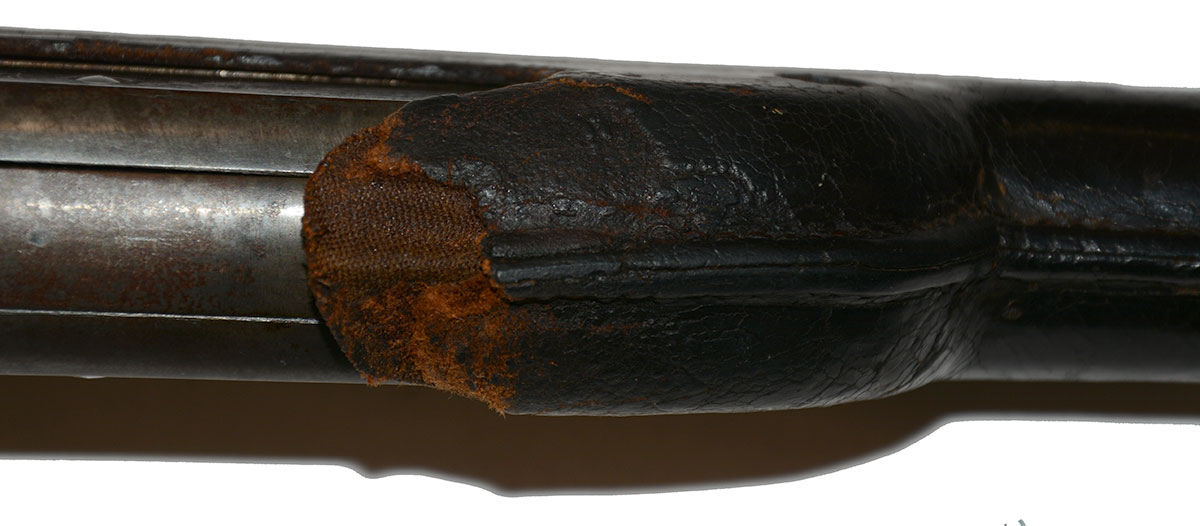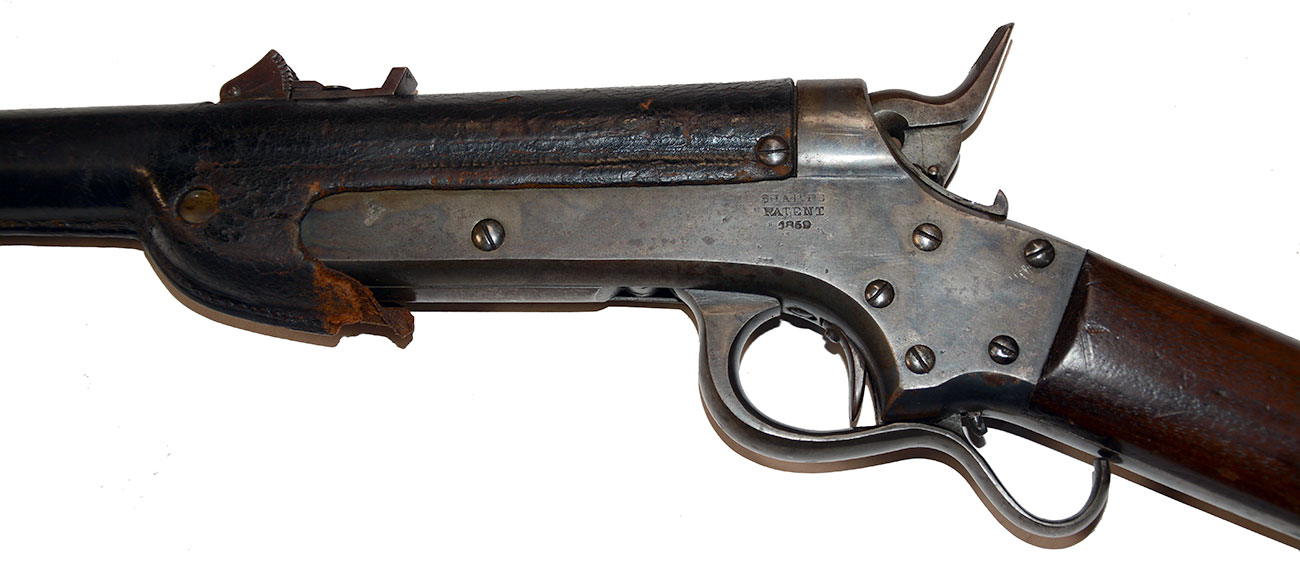site search
online catalog
SHARPS AND HANKINS NAVY CARBINE

Hover to zoom
















$3,250.00
Quantity Available: 1
Item Code: 1224-01
Shipping: Determined by Method & Location of buyer
To Order:
Call 717-334-0347,
Fax 717-334-5016, or E-mail
This is a good example of the single-shot, breech-loading .52 Caliber rimfire Sharps and Hankins Navy Carbine, also known as the Second Model or Model 1862, complete, all original, and showing some faded case colors on the frame. These carbines used a 24-inch barrel with waterproofed leather covering for the barrel and forward part of the frame, with sewn seam and held by screws on the lower portion of the barrel assembly. Both sights are in place. The front sight is a simple blade on short block mounted on a band around the muzzle. The rear sight is a tangent style with single long leaf having a notched block at the rear and pivoting forward with the range graduated from 100 to 1800 yards on the side of the pivot housing, and is complete and in very good condition with distinct notches and markings, showing gray with some thin, faded blue. The leather is good, showing crazing to the surface and some minor rubs and flakes, but generally good color and surface though edge of the frame covering shows losses of leather and finish from the movement of the lever, barrel and frame.
The frame, breech, and hammer show some gray and brown, but also the mottled blues, grays and lighter colors of case hardening. The rounded screw heads show lighter from rubbing, but the screw tips show some blue. The markings are sharp: “SHARPS / & / HANKINS / PHILADA” on the right and “SHARPS / PATENT / 1859” on the left. The upper and lower tangs show good thin blue, with blue on the screwheads. The serial number 11253 crisp on the upper tang. The lower tang shows a little lighter from handling. The buttstock has a tight fit to the frame, good surface, finish, and color, with just a few small scratches on the left near the buttplate and a very small pressure dent near the top. The brass buttplate has a nice, mellow color with some thin brown age tones. The sling swivel is in place on the bottom of the butt stock- these were used with a shoulder sling adjusting through the swivel on one end and buckling around the barrel on the other. Mechanics function well; nice, clean bore with good rifling.
Christian Sharps had left the Sharps Rifle Manufacturing Company in 1853 and moved to Philadelphia where he started a new company that eventually became C. Sharps & Company in 1858. William Hankins joined the firm in 1860 as superintendent of the rifle works and became a full partner in 1862. (The firm was renamed Sharps & Hankins in 1863.) The company produced both rifles and carbines for the army and navy using a Sharps and Hankins .52-56 rimfire cartridge. The action uses a lever release catch under and behind the trigger permitting the lever/triggerguard to be lowered, sliding the barrel forward on the frame to insert the cartridge. The improved second model has a floating firing pin in the breech and an external sliding safety that can block the hammer from meeting the firing pin, and can be automatically drawn out of the way by pulling the hammer all the way back. They also solved the problem of fired cases sticking in the breech by fitting the breech block with a pin mounted on a spring that would latch in front of the case rim on the bottom once the cartridge was fully seated, and hold it in place after firing, with the cam action of the lever essentially drawing the breech forward from around the cartridge case.
Serial numbers encompassed several models and variations. Carbine production is estimated at about 8,000, with the Navy buying a tad under 6,700 and the army some 1,400, though there was a shorter barrel version apparently purchased by New York State, with a few also going to the Navy, as well as some 600 rifles. Navy purchases were scattered from 1862 though 1865, so the numbers cover the whole production range. For fuller discussion see McAulay’s books on carbines, Sellers, and Coates & McAulay on Sharps in particular.
These carbines were used aboard ship and in picket boats, and also by landing parties. In the western waters gunboats often had to deal with ambushes and harassment from shore and there many smaller boat actions, as well as larger landing operations such as the assault on Fort Fisher. See McAulay, Civil War Small Arms of the U.S. Navy and Marine Corps for more particulars of their navy use, issue, and holdings on specific vessels. Sharps and Hankins carbines often show heavy use and the rigors of service on the water and are frequently missing the leather barrel covering in part or entirely. This one is a very good example. [SR] [ph:L]
~~~~~~~~~~~~~~~~~~~~~~~~~~~~~~~~~~~
THIS ITEM, AS WITH ALL OTHER ITEMS AVAILABLE ON OUR WEB SITE,
MAY BE PURCHASED THROUGH OUR LAYAWAY PROGRAM.
CLICK HERE FOR OUR POLICIES AND TERMS.
THANK YOU!
Inquire About SHARPS AND HANKINS NAVY CARBINE
Most Popular
Historical Firearms Stolen From The National Civil War Museum In Harrisburg, Pa »
Theft From Gravesite Of Gen. John Reynolds »
Selection Of Unframed Prints By Don Troiani »
Fine Condition Brass Infantry Bugle Insignia »
Large English Bowie Knife With Sheath 1870’S – 1880’S »
Imported (Clauberg) Us Model 1860 Light Cavalry Officer's Saber »
featured item
RARE USN GOSPORT NAVY YARD PRIMING FLASK
Gosport Shipyard was the original name of the facility in Portsmouth, Virginia, that was founded in 1767, passed into the hands of Virginia in the Revolution, was leased from that state by the U.S. government in 1794, purchased by them in 1801 and… (490-6824). Learn More »


